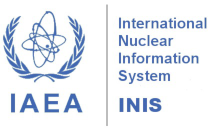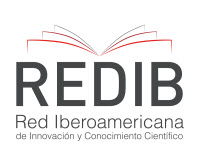Use of Lymphoscintigraphy Images in Nuclear Medicine to Obtain the Distribution of 99mTc Photons in Computational Exposure Models
DOI:
https://doi.org/10.15392/2319-0612.2025.2909Keywords:
Nuclear Medicine, Lymphoscintigraphy, Image Processing, Computer-Assisted, Computer SimulationAbstract
This study aims to create a source catalog for Lower Limb Lymphoscintigraphy (LLL) examinations in Nuclear Medicine, using real lymphoscintigraphy images from adult male patients. The DIP (Digital Image Processing) software, developed by the Research Group on Computational Dosimetry and Embedded Systems (GPDC&SE), was used to adjust the anteroposterior (AP) and posteroanterior (PA) medical images to the frontal section of the anthropomorphic phantom MASH_sup (Male Adult meSH in supine position). The images were summed line by line, generating a .SGI file, which was processed by the Monte Carlo software to produce the source catalog stored in the file MSUPLC_TC99m.txt. This file contains information for each slice, including the slice number, the area of the source points, and the value of the associated cumulative distribution function (CDF). As a result, a catalog based on real clinical data was successfully generated, which enables the replacement of generic internal sources in the Computational Exposure Models of the GPDC&SE. This makes it possible to simulate LLL examinations more realistically. In the future, this methodology may be extended to female patients, different phantoms, and other scintigraphic procedures. This work represents an advancement in computational dosimetry and personalized nuclear medicine, as it enables simulations that more accurately reflect patient-specific anatomical and physiological characteristics.
Downloads
References
[1] Sociedade Brasileira de Física Médica. CONHEÇA A MEDICINA NUCLEAR. 2021. Disponível em: https://sbmn.org.br/comunicacao/conheca-a-medicina-nuclear/. Acessed on: 28 jun. 2021.
[2] ZIESSMAN, H. A.; O'MALLEY, J. P.; THRALL, J. H.; FAHEY, F. H. Medicina nuclear. Tradução Silvia Mariangela Spada. 4. ed. Rio de Janeiro: Elsevier, 2015.
[3] HIRONAKA, F. H.; SAPIENZA, M. T.; ONO, C. R.; LIMA, M. S.; BUCHPIGUEL, C. A. Medicina Nuclear: princípios e aplicações. São Paulo: Atheneu, 2012.
[4] SADEGHI, R.; KAZEMZADEH, G.; KESHTGAR, M. Diagnostic application of lymphoscintigraphy in the management of lymphoedema. Hell J Nucl Med, v. 13, n. 1, p. 6-10, 2010.
[5] SZUBA, A.; SHIN, W. S.; STRAUSS, H. W.; ROCKSON, S. The third circulation: radionuclide lymphoscintigraphy in the evaluation of lymphedema. Journal of Nuclear Medicine, v. 44, n. 1, p. 43-57, 2003.
[6] BARRAL, C. M.; STEHLING, A. P.; SILVA, A. C. M.; CASTRO, A. C.; IVO, C. S.; KORMAN, D. E.; MAGALHÃES, L. N.; CARVALHO, L. A.; FÉLIX, M. T. M.; MACHADO, F. S. Linfocintilografia de membros inferiores: estudo retrospectivo de 154 casos no período de março de 2009 a junho de 2010. Revista Médica de Minas Gerais, v. 23, n. 2, p. 182–192, 2013. DOI: https://doi.org/10.5935/2238-3182.20130030
[7] DONOHOE, K. J.; CARROLL, B. J.; CHUNG, D. K. V.; DIBBLE, E. H.; DIEGO, E.; GIAMMARILE, F.; GRANT, F. D.; LAI, S. Y.; LINDEN, H.; MILLER, M. E.; PANDIT-TASKAR, N.; TAWA, N. E. Jr.; VIDAL-SICART, S. Summary: Appropriate Use Criteria for Lymphoscintigraphy in Sentinel Node Mapping and Lymphedema/Lipedema. Journal of Nuclear Medicine, v. 64, n. 4, p. 525–528, abr. 2023. DOI: 10.2967/jnumed.123.265560. DOI: https://doi.org/10.2967/jnumed.123.265560
[8] ABOIA, L. S.; MENEZES, A. F.; CARDOSO, M. A. C.; ROSA, L. A. R. da; BATISTA, D. V. S.; CARDOSO, S. C.; SILVA, A. X.; FACURE, A. Application of digital image processing for the generation of voxels phantoms for Monte Carlo simulation. Applied Radiation and Isotopes, v. 70, n. 1, p. 144–148, 2012. DOI: 10.1016/j.apradiso.2011.08.017. DOI: https://doi.org/10.1016/j.apradiso.2011.08.017
[9] LEE, H. Monte Carlo methods for medical imaging research. Biomedical Engineering Letters, v. 14, p. 1195–1205, 2024. DOI: 10.1007/s13534-024-00423-x DOI: https://doi.org/10.1007/s13534-024-00423-x
[10] VIEIRA, J. W. Construção de Um Modelo Computacional de Exposição para Cálculos dosimétricos Utilizando o Código EGS4 e Fantomas de Voxels. Tese de Doutorado, PROTEN, UFPE, Recife, Pernambuco, 2004.
[11] CABRAL, M. O. M. Desenvolvimento de Um Modelo Computacional de Exposição para Uso em Avaliações Dosimétricas em Gestantes. Dissertação de Mestrado, PROTEN, UFPE, Recife, Pernambuco, 2015.
[12] CASSOLA, V. F. Desenvolvimento de fantomas humanos computacionais usando malhas poligonais em função da postura, massa e altura. Tese de Doutorado, PROTEN, UFPE, Recife, Pernambuco, 2011.
[13] VIEIRA, J. W.; LIMA, F. R. A. A software to digital image processing to be used in the voxel phantom development. Cell and Molecular Biology, 2009, v. 3, p. 16-22. doi: 10.1170/T869.
[14] VIEIRA, J. W. Uso de Técnicas Monte Carlo para Determinação de Curvas de Isodose em Braquiterapia. Dissertação de Mestrado, PROTEN, UFPE, Recife, Pernambuco, 2001.
[15] VIEIRA, J. W.; LEAL NETO, V.; LIMA FILHO, J. M.; LIMA, L. F.; LOPES FILHO, F. J.; ROCHA, E. A.; LIMA, F. R. A. Estimate of dose distribution in voxel phantom irradiated by a planar source modeled by translational normal probability density functions. In: 2012 International Symposium on Radiation Physics, Rio de Janeiro, 2012.
[16] VIEIRA, J. W.; LEAL NETO, V.; LIMA FILHO, J. M.; LIMA, L. F.; LIMA, F. R. A. Modelagem Monte Carlo de regiões dos ossos trabeculares de adultos para uso em modelos computacionais de exposição. In: Terceiro Congresso de Proteção Contra Radiações da Comunidade dos Países de Língua Portuguesa, Lisboa, 2012.
[17] VIEIRA, J. W.; LEAL NETO, V.; LIMA FILHO, J. M.; LIMA, F. R. A. Transformation of the normal distribution for Monte Carlo modeling of regions of adult trabecular bones for use in computational models of exposure. In: 13th International Congress of the International Radiation Protection Association, Glasgow, 2012.
Downloads
Published
Issue
Section
Categories
License
Copyright (c) 2025 Jorge Alexandre Gomes Lins, José Wilson Vieira, Fernando Roberto de Andrade Lima, Whoody Alem Wanderley Araripe Farias , Victor Hugo Farias Ferreira da Silva; João Mário da Silva; Ferdinand de Jesus Lopes Filho, Jefferson Melo Gonçalves Pena, Larissa Cristina Silva dos Santos

This work is licensed under a Creative Commons Attribution 4.0 International License.
Licensing: The BJRS articles are licensed under a Creative Commons Attribution 4.0 International License, which permits use, sharing, adaptation, distribution and reproduction in any medium or format, as long as you give appropriate credit to the original author(s) and the source, provide a link to the Creative Commons license, and indicate if changes were made. The images or other third party material in this article are included in the article’s Creative Commons license, unless indicated otherwise in a credit line to the material. If material is not included in the article’s Creative Commons license and your intended use is not permitted by statutory regulation or exceeds the permitted use, you will need to obtain permission directly from the copyright holder. To view a copy of this license, visit http://creativecommons.org/licenses/by/4.0/






















